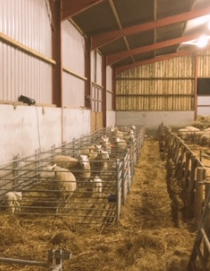🐑 What to Expect from Lambing Work Experience: A Guide for Vet School Applicants - Part 1
/For some, the lambing season is already in full swing, while for others, preparations are well underway. If you're considering lambing work experience as part of your pre vet work experience, it’s crucial to understand the farmer’s goals before you visit. Are they aiming for early lambing to sell their lambs at a premium price in the Easter market? Or perhaps they’re lambing later in the season and raising lambs on fresh grass to produce a lower-input, more sustainable product? Do they sell store lambs or finished lambs? These are just a few examples of different farming approaches.
So, what should you know before embarking on your lambing placement? Understanding the farm's production goals will help you engage with the tasks, contribute meaningfully, and reflect on your experiences during vet school interviews. By gaining insight into lambing practices and agricultural methods, you’ll be better prepared for those vet school interview questions about animal welfare, farming systems, and the role of vets in livestock production.
So… What do you need to know before going on a lambing placement?
View from a hill farm.
What time of farm is it?
Understanding the type of sheep farm you’re visiting is essential for making the most of your lambing work experience. There are several types of farming systems, with the broad categories being hill, upland, and lowland farms. Each system requires ewes with specific traits, and knowing these differences will help you gain a deeper understanding of animal husbandry practices.
For example, hill flocks typically require ewes with a strong mothering instinct to protect their lambs from predators and harsh weather conditions. However, these ewes are generally less prolific, often producing a single lamb per birth. In contrast, lowland flocks are more focused on prolificacy, meaning the ewes are bred to produce twins or even triplets. These ewes are often lambed indoors earlier in the season to protect the lambs and ensure optimal growth.
Understanding the differences between these farming systems will allow you to engage more effectively during your pre vet work experience and discuss various lambing methods, production goals, and animal care practices during your vet school interview.
Indoor lambing with each ewe and her lamb/lambs in an individual pen.
Breed of Sheep
Understanding the breed of sheep you’ll be working with is crucial during your lambing work experience, especially as certain breeds are more prone to specific lambing complications. One of the most common challenges in sheep lambing is dystocia, which refers to difficulty during birth. Some breeds are more predisposed to dystocia than others, particularly those with larger body types or muscular builds.
Double-muscled breeds, such as Beltex and Texels, along with any other breeds that have large shoulders and rumps, are more likely to experience birthing difficulties. This is because the pelvic canal of the ewe may be too narrow to allow the lamb’s shoulders and hindquarters to pass through easily. In some cases, this can lead to the need for a caesarean section to assist with the delivery.
As part of your pre vet work experience, it’s essential to assess the ewe’s pelvic size and the shoulder/hindquarter width of the lambs before attempting to assist in the birth. This knowledge will be invaluable when discussing lambing techniques or veterinary intervention during your vet school interviews, particularly when it comes to animal welfare, breeding issues, and surgical procedures.
Vaccination Status of the Flock
During your lambing work experience, it’s crucial to understand the vaccination status of the flock, as this can significantly impact the occurrence of diseases during lambing. Two highly contagious diseases that are common in sheep flocks during lambing are toxoplasmosis and enzootic abortion. Both of these diseases can be prevented through vaccination, although the cost of the vaccines means that vaccination status can vary between farms.
Toxoplasmosis is caused by a protozoan parasite. It can lead to a range of symptoms, but the two most common signs are:
Barren ewes at scanning (due to reabsorption of the fetus in early pregnancy), and
Lambing abnormalities, including mummified fetuses, weak lambs, and stillborn lambs.
Enzootic abortion is a bacterial disease that causes premature lamb deaths. The two main clinical signs are:
Premature stillborn lambs, typically occurring two weeks before the due date, and
A red, thickened placenta.
If either disease is suspected, immediate action is needed. The ewe showing clinical signs should be isolated from the rest of the flock to prevent further spread. Any placental and fetal material should be carefully removed, and the foetus and placenta should be kept as clean as possible. It’s important to call a veterinary surgeon to take samples for testing and confirm the presence of the disease. Additionally, the area where the abortion occurred should be thoroughly disinfected to minimize the risk of further contamination.
This knowledge is vital for anyone pursuing pre vet work experience, as understanding disease management during lambing is a crucial topic in vet school interviews. You may be asked about your role in managing animal welfare and how you would respond to such situations.
If you are interested in sheep husbandry and handling and would like to come and learn more we will be running sheep courses all year round. Click below for more information.












